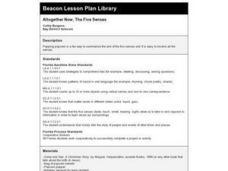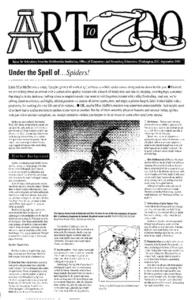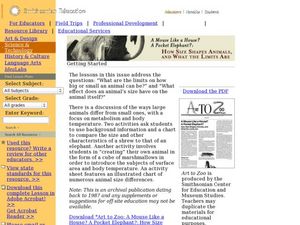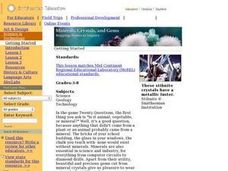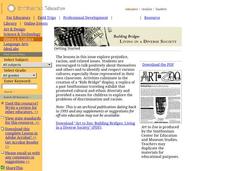Curated OER
Altogether Now, The Five Senses
Students make popcorn to summarize end of five senses unit.
Curated OER
Plants and Animals, Partners in Pollination
Students participate in multiple hands-on activities to explore reproduction and pollination. In groups, using a cotton swab and powder, students simulate being pollinators and plants. They name the parts of the flowers and the function...
Curated OER
Rocks and Minerals
Learners bring rocks and minerals from home to investigate in the classroom. In this rocks and minerals lesson plan, students observe all the rocks and minerals brought into the class and answer 7 questions about the features of the...
Curated OER
Under the Spell of Spiders
Young scholars examine spiders. In these spider lessons, students will view spider images and live spiders to determine physical characteristics, habits, and habitats. Young scholars will examine fantasy and folklore about spiders to...
Curated OER
"ART ZOO 'Blacks in the Westward Movement', 'What Can You Do with a Portrait', and 'Of Beetles, Worms, and Leaves of Grass'"
Students study black history, examine portraits and portrait making and create their own portraits, and investigate their natural environment. This humanities activity provides a text that can be used to teach lessons in black history,...
Curated OER
How Size Shapes Animals
Students investigate how size affects large and small animals differently. In this animal lesson plan, students determine how size affects different animals by constructing their own animal out of marshmallows. Once students create...
Curated OER
Fossils Footprints Across Time
Learners examine fossils to understand how they are formed and how they give information about geological history. In this fossil lesson plan, students research and write about fossils and make models of different fossil types.The PDF...
Curated OER
Communities
Students discuss what makes a community. They identify different types of communities and how they evolve over time. They examine the role they have in their community.
Curated OER
Solar Power
Students discover how engineers use solar energy to heat buildings. They investigate the thermal properties of different materials. They evaluate the usefulness of each material.
Curated OER
Minerals, Crystals, and Gems
Young scholars discover the relationships between minerals, crystals and gems. They bring in rocks that they find at home, in the schoolyard, etc. and examine them and attempt to identify them. They set up a classroom exhibit that...
Curated OER
Japan: Images of a People
Students learn the geography of Japan and its location in reference to the United States.
Curated OER
Marketing
Students view a "Marketing" a painting by Robert Gwathmey. Using the painting, they explain the use of symbols and the placement of shapes. In older grades, they identify the relationship between the elements of art and the principles of...
Curated OER
Plant Classification
Students participate in an experiment that involves plant classification. They identify and are able to employ three methods of classifying leaves. Each student classifies leaves by each of the following methods: K-I 4.b, d, & e;...
Curated OER
Lift and Drag: Principles of Flight and the Soaring Imagination
Students construct models of early gas balloons and gliders. In this balloon and glider lesson, students create models of early gas balloons and gliders, discover how the forces of lift and drag effect aircraft in flight, and put on...
Curated OER
Building Bridges: Living in a Diverse Society
Young scholars participate in various activities that help them build esteem, and explore racism. In this multicultural lesson plan, Students increase their awareness of, and appreciation for, cultural differences and similarities. ...
Curated OER
Tread Lightly: Where We Stand
Students explore the concept of ecological footprints. In this environmental stewardship lesson, students calculate their ecological footprints and consider how to reduce them.
Curated OER
What's Hiding in the Air?
Fifth graders conduct experiments to study the effects of invisible air pollutants including one with a bean plant. They examine methods of invisible air pollutants.
Curated OER
Anna's Dilemma
Students read a scenerio about people who lived in Germany during Nazi rule. As a class, they discuss the situations the character finds herself in and identify her responsiblities to her family. They answer discussion questions and...
Curated OER
Challenges in Changing the Face of a City
Students examine a video in which people want to change the city of Oakland, California. They decide on the best course of action.
Curated OER
Spy on a Spider
Students view slides or live specimens to name and describe the distinguishing features of groups of arthropods, especially spiders and insects. They complete worksheets, observe webs and then search for and record where spiders can be...
Curated OER
The Hammock
Students examine the artwork of Frieseke. Using various paintings, they examine its characteristics and discuss how the artist creates movement and rhythm in the artwork. At higher grades, they describe the properties of colors and...
Curated OER
The Black Prince at Crecy
Students analyze how artists have applied color relationships (value, intensity, tints, and shades, cool and warm colors) to create descriptive and expressive effects in artworks. They judge an artwork based on whether its organization...
Other popular searches
- Business Law High School
- Business Law Contracts
- Business Law Lesson Plans
- Business Law Projects
- Business Law Consideration
- Introduction to Business Law
- Business and Law Dictionaries
- Business Law Ethics
- Business Law and Ethics
- Business Law Contracts Music
- Multiple Business Law
- Business Law Contracts Fraud


